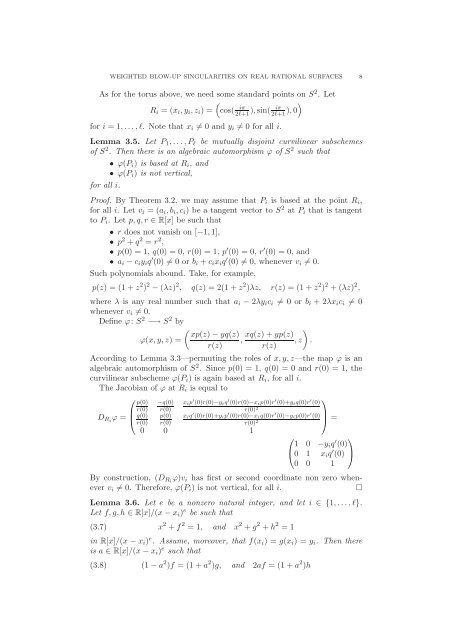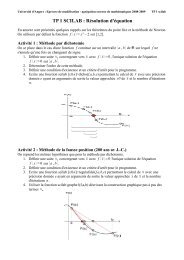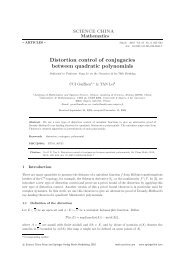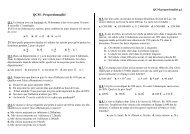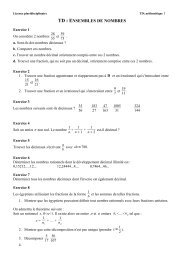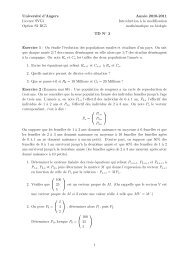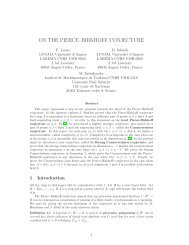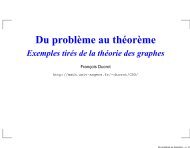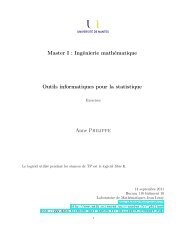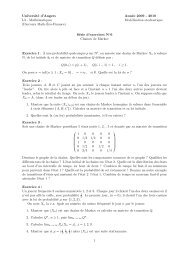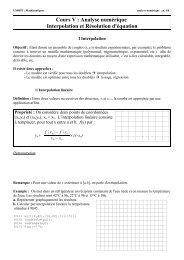automorphisms of real rational surfaces and weighted blow-up ...
automorphisms of real rational surfaces and weighted blow-up ...
automorphisms of real rational surfaces and weighted blow-up ...
Create successful ePaper yourself
Turn your PDF publications into a flip-book with our unique Google optimized e-Paper software.
WEIGHTED BLOW-UP SINGULARITIES ON REAL RATIONAL SURFACES 8<br />
As for the torus above, we need some st<strong>and</strong>ard points on S2 . Let<br />
<br />
Ri = (xi,yi,zi) = cos( iπ iπ<br />
2ℓ+1 ),sin( 2ℓ+1 ),0<br />
<br />
for i = 1,... ,ℓ. Note that xi = 0 <strong>and</strong> yi = 0 for all i.<br />
Lemma 3.5. Let P1,... ,Pℓ be mutually disjoint curvilinear subschemes<br />
<strong>of</strong> S 2 . Then there is an algebraic automorphism ϕ <strong>of</strong> S 2 such that<br />
• ϕ(Pi) is based at Ri, <strong>and</strong><br />
• ϕ(Pi) is not vertical,<br />
for all i.<br />
Pro<strong>of</strong>. By Theorem 3.2, we may assume that Pi is based at the point Ri,<br />
for all i. Let vi = (ai,bi,ci) be a tangent vector to S 2 at Pi that is tangent<br />
to Pi. Let p,q,r ∈ R[x] be such that<br />
• r does not vanish on [−1,1],<br />
• p 2 + q 2 = r 2 ,<br />
• p(0) = 1, q(0) = 0, r(0) = 1, p ′ (0) = 0, r ′ (0) = 0, <strong>and</strong><br />
• ai − ciyiq ′ (0) = 0 or bi + cixiq ′ (0) = 0, whenever vi = 0.<br />
Such polynomials abound. Take, for example,<br />
p(z) = (1 + z 2 ) 2 − (λz) 2 , q(z) = 2(1 + z 2 )λz, r(z) = (1 + z 2 ) 2 + (λz) 2 ,<br />
where λ is any <strong>real</strong> number such that ai − 2λyici = 0 or bi + 2λxici = 0<br />
whenever vi = 0.<br />
Define ϕ: S2 −→ S2 by<br />
<br />
xp(z) − yq(z)<br />
ϕ(x,y,z) =<br />
,<br />
r(z)<br />
xq(z) + yp(z)<br />
<br />
,z .<br />
r(z)<br />
According to Lemma 3.3—permuting the roles <strong>of</strong> x,y,z—the map ϕ is an<br />
algebraic automorphism <strong>of</strong> S2 . Since p(0) = 1, q(0) = 0 <strong>and</strong> r(0) = 1, the<br />
curvilinear subscheme ϕ(Pi) is again based at Ri, for all i.<br />
The Jacobian <strong>of</strong> ϕ at Ri is equal to<br />
⎛<br />
⎞<br />
DRiϕ =<br />
⎜<br />
⎝<br />
p(0)<br />
r(0)<br />
q(0)<br />
r(0)<br />
−q(0)<br />
r(0)<br />
p(0)<br />
r(0)<br />
xip ′ (0)r(0)−yiq ′ (0)r(0)−xip(0)r ′ (0)+yiq(0)r ′ (0)<br />
r(0) 2<br />
xiq ′ (0)r(0)+yip ′ (0)r(0)−xiq(0)r ′ (0)−yip(0)r ′ (0)<br />
r(0) 2<br />
0 0 1<br />
⎟<br />
⎠ =<br />
⎛<br />
⎝ 1 0 −yiq ′ (0)<br />
0 1 xiq ′ ⎞<br />
(0) ⎠<br />
0 0 1<br />
By construction, (DRi ϕ)vi has first or second coordinate non zero whenever<br />
vi = 0. Therefore, ϕ(Pi) is not vertical, for all i. <br />
Lemma 3.6. Let e be a nonzero natural integer, <strong>and</strong> let i ∈ {1,... ,ℓ}.<br />
Let f,g,h ∈ R[x]/(x − xi) e be such that<br />
(3.7) x 2 + f 2 = 1, <strong>and</strong> x 2 + g 2 + h 2 = 1<br />
in R[x]/(x − xi) e . Assume, moreover, that f(xi) = g(xi) = yi. Then there<br />
is a ∈ R[x]/(x − xi) e such that<br />
(3.8) (1 − a 2 )f = (1 + a 2 )g, <strong>and</strong> 2af = (1 + a 2 )h


